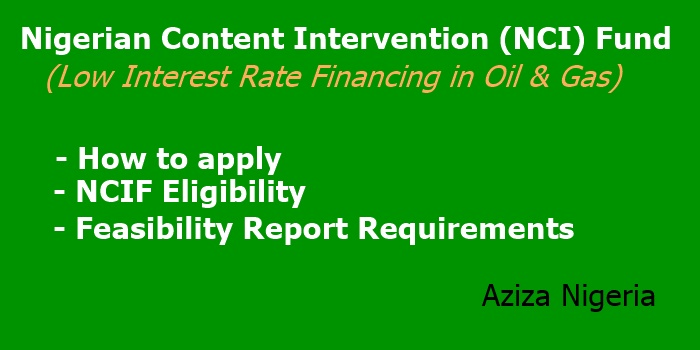This post covers how to access Nigerian Content Intervention (NCI) Fund, who is eligible to access the NCI Fund, how to prepare your Feasibility Study Report so as to access the Nigerian Content Intervention (NCI) Fund and many more.
The Nigerian Content Intervention Fund (NCIF) was motivated by the desire to re-engineer the operations of the NCDF, increase access to funding and grow indigenous participation in the oil and gas industry.
The 1% Nigerian Content Intervention (NCI) Fund is a pool of funds made available by the Nigeria Content Development and Monitoring Board (NCDMB) to be managed by the Bank of Industry to meet the funding needs of indigenous manufacturers, service providers and other key players in the Nigerian Oil and gas Industry.
The One (1%) Percent NCI Fund
The Nigerian Content Development and Monitoring Board (NCDMB) and key organisations in the oil and gas industry – the Petroleum Technology Association of Nigeria (PETAN), Petroleum Contractors Trade Section (PCTS), Oil Producers Trade Section (OPTS) and the Nigeria LNG Ltd have advised against increasing the percentage of the Nigerian Content Development Fund (NCDF) from the current one (1%) percent to two (2%) percent as proposed in the amendment of the Nigerian Oil and Gas Industry Content Development (NOGIDC) Act.
Read: How to Register with Nigeria Content Development and Monitoring Board (NCDMB)
Types of facility that can be fund under the Nigerian Content Intervention (NCI) Fund
The Nigeria Content Development and Monitoring Board (NCDMB) will use the NCI Fund to finance the following facilities:
- Term loans,
- Working Capital,
- Invoice Discounting
- Leasing facility
NCI Finding Interest rate are as follows:
- Manufacturing Loan – 8%
- ii)Asset acquisition Loan – 8%
- Contract finance Loan – 8%
- Community Contractor Finance Scheme – 5%
- Loan Re-financing – 8%
Eligibility to Access the NCI Fund
The Nigerian Content Intervention (NCI) Fund will be accessible to contributors to the NCDF as well as community contractors of any of the oil producing communities.
Amount to Access Under Nigerian Content Intervention (NCI) Fund
Applicants who are eligible to apply for the Nigerian Content Intervention (NCI) Fund have maximum amount they can apply for in one application (a single obligor limit) under each loan type. The single obligor limit for the available types of funding are detailed below:
- i)Manufacturing Loan – US$10million
- ii)Asset acquisition Loan – US$10million
- iii)Contract finance Loan – US$5million
- iv)Community Contractor Finance Scheme – N20million
- v)Loan Re-financing – US$10million
How to Apply For Nigerian Content Intervention (NCI) Fund
All applications can only be made through the Bank Of Industry (BOI) Nigerian Content Intervention (NCI) Fund portal (www.boi.ng/ncifund).
Upon submission of the application, it takes forty-five (45) working days to access the loan. This is subject to fulfillment of all terms and conditions and contract confirmation from an International Oil Company (IOC), where applicable.
Requirements & Application Contents
Different documents are required for the different types of loan available (this can the accessed on the website) but a major requirement for all loan types is a detailed Feasibility Report containing the following:
Introduction & Background: This shows information on the company’s activities since incorporation, biographies of shareholders of the company and their percentage shareholding, project concept which is the need for the project and the detailed project description.
Read: How to apply for DPR Permit, Requirements & Cost
List Of Information Expected In The NCIF Feasibility Study Report
1) Information on the company’s activities since incorporation.
2) Biographies of shareholders of the company and their percentage shareholding.
3) Projects concept, the need for the project and detail project description
4) Details of the project cost as well as the proposed financing plan with realistic assessment and evidence of availability of funds from each source.
5) Details of existing assets and the value as well as cost incurred on the proposed project till date.
6) Installed capacity and a detailed analysis of the annual cost of production and cash flow and balance sheet projections for at least the first five years with relevant assumptions.
7) Detailed technical information covering technology, production process etc.
8) Information on Technical Partners, if any.
Read: NipeX Registration a New Vendor
9) Comprehensive list of machinery required, giving detailed specifications, source(s) and prices.
10) Details of utility requirements and availability of essential services such as water, power, transport around the project site.
11) Detailed information on raw material requirements, their sources and unit cost.
12) Comprehensive list of manpower requirements broken down into categories and salaries.
13) List, qualification and position and annual salary of existing management and staff (for expansion projects only).
14) Detailed market study report, covering the following areas:
(a) Supply analysis with information/data on names, location and installed capacities of existing and known potential competitors, import data for the products(s) Trend of future supply (local + import).
(b) Demand analysis comprising factors influencing demand, estimate of domestic demand, export potentials – all based on current and future trend.
(c ) Market prospects with information on existing planned marketing arrangements, distribution strategies, current and proposed selling prices vis-à-vis competitors, prices (local and import prices).
15) For on-going projects, give the existing, Expansion/Diversification and Consolidated projections covering Profit and Loss Accounts, Cash Flow Analysis and Balance Sheets for the period of five (5) years. Also provide the detailed information/data and assumptions used in the above projections.
Conclusion:
Nigerian Content Intervention (NCI) Fund is real and any eligible and qualified company should apply. Applications can only be made through the Bank Of Industry (BOI) of any branch.

